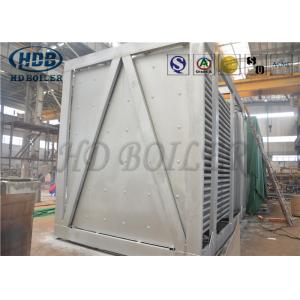

Add to Cart
General Introduction
Air preheater is a kind of equipment which can improve the heat
exchange performance of the boiler and reduce the energy
consumption. The function of the air preheater is to heat the flue
gas discharged from the tail flue of the boiler and transmit it to
the air before entering the boiler through the radiator, so as to
preheat the air to a certain temperature.
The air preheater is generally used for coal-fired boilers in power
station.It can be divided into tubular type and rotary type. The
rotary type can be further divided into wind hood rotary type and
heating surface rotary type.Power stations usually use the heating
surface rotary air preheater. Generally, the application in boilers
is two-compartment, three-compartment and four-compartment, among
which the four-compartment is more commonly used in CFB boilers.
Classification
According to the way of heat transfer, the air preheater can be
divided into two types:heat conduction type and regeneration
type.Among the heat conduction type, tubular air preheater is most
commonly used.With the increase of boiler parameters and capacity,
the heating surface of tubular air preheater increases, which
brings difficulties to the arrangement of the tail heating surface.
Therefore, most of the large capacity units adopt a compact, light
weight rotary air preheater. Air preheater is generally divided
into three types: plate type, rotary type and tubular type.
The main heat transfer component of tubular air preheater is
thin-walled steel tube. The tubular air preheaters are mostly
cubic. The steel tubes are arranged vertically and staggered with
each other. Both ends are welded on the upper and lower tube
sheets.The tubular air preheater is equipped with an intermediate
tube sheet in the tube box. The flue gas passes through the
preheater up and down the pipe, while the air passes through the
preheater horizontally to complete heat transfer.
Tubular air preheater is widely used in power station boilers and
industrial boilers because of its advantages of good sealing, high
heat transfer efficiency, easy manufacturing and processing. The
shortcomings of tubular air preheater are large volume, easy ash
plugging of steel tube content, difficult cleaning and easy wear
and tear at flue gas inlet.
Ancillary system
Rotary air preheater mainly includeds fire alarm(hot spot detection), clearance adjustment, frequency conversion control, lubricating oil system, rotor stop alarm system, soot blowing and cleaning system, etc..
The key problems affecting the performance of rotary air preheater are air leakage, corrosion and ash plugging. In the design of tubular air preheater, air flow rate and tube box size should be reasonably selected, or vibration isolation board should be installed along the direction of air flow to prevent cavity resonance.Vibration isolation board also have the function of eliminating noise. Air leakage of rotary air preheater is an important problem. Measures should be taken in desgin, manufacturing, installation and operation to keep reasonable sealing gap between dynamic and static components in thermal state.When burning high sulfur fuel, both tubular and rotary preheater are prone to corrosion and ash plugging.The preventive measures include:installing heater or hot air recirculation at the air inlet; using low oxygen combustion or mixing combustion additives to reduce the production of SO2 gas in flue gas; blowing ash regularly to keep the heating surface clean; using corrosion-resistant materials on the heating surface, etc.
Parameter
Layout item | Horizontal layout | Vertical layout |
| Tube arrangement | staggered arrangement / | staggered arrangement / |
| Sealing of pipe and plate | Packing heat- resistant material/ | welding |
| Anti-wearing | a,when gas scours external tube, welcoming smoke tubes have
protective tile | |
Enamel air preheater products are classified as following by
application
1.Enamel heat exchanger designed for denitration renovation
projects
2.Enamel heat exchanger for circulating fluidized bed boiler and
pulverized coal boilers Heat
exchanger parts for garbage incinerators and biomass boilers
3.Heat exchanger parts for grate furnaces, like chain grate
furnaces4.Heat exchanger parts for gas-fueled boilers, such as
kerosene boilers, coke ovens, etc.
